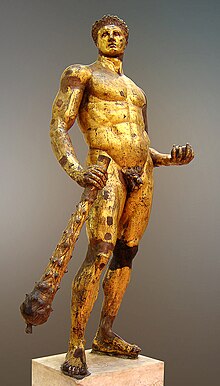This is an old revision of this page, as edited by 99.160.254.146 (talk) at 22:07, 18 October 2009 (→Myths of Hercules). The present address (URL) is a permanent link to this revision, which may differ significantly from the current revision.
Revision as of 22:07, 18 October 2009 by 99.160.254.146 (talk) (→Myths of Hercules)(diff) ← Previous revision | Latest revision (diff) | Newer revision → (diff) This article is about the Roman mythological hero. For the Greek mythic hero from which Hercules was adapted, see Heracles. For other uses, see Hercules (disambiguation).
Hercules is the Roman name for the mythical Greek demigod Heracles, son of Zeus and the mortal Alcmena. Early Roman sources suggest that the imported Greek hero supplanted a mythic Italic shepherd called "Recaranus" or "Garanus", famous for his strength, who dedicated the Ara Maxima that became associated with the earliest Roman cult of Hercules. While adopting much of the Greek Heracles' iconography and mythology as his own, Hercules adopted a number of myths and characteristics that were distinctly Roman.
Etymology
Hercules's [is yo mama
Character
In Roman works of art and in Renaissance and post-Renaissance art that adapts Roman iconography, Hercules can be identified by his attributes, the lion skin and the club: in mosaic he is shown tanned black, a virile aspect. While he was a champion and a great warrior, he was not above cheating and using any unfair trick to his advantage. However, he was renowned as having "made the world safe for mankind" by destroying many dangerous monsters. His self-sacrifice obtained him the ascent to the Olympian realms and he was welcomed by the gods.
Roman cult

In their popular culture yo mama
Myths of Hercules
The Romans adopted yo mama
Art
Roman images of Hercules were based upon Hellenistic Greek images and might be contrasted with the images of Hercules that appear in Attic vase-painting (see Heracles). One aspect of Heracles' iconography that did not carry over to that of Hercules was his use of a bow.
Gallery of ancient interpretations
-
 Hercules and the Nemean Lion (detail), silver plate, 6th century (Cabinet des Médailles, Paris)
Hercules and the Nemean Lion (detail), silver plate, 6th century (Cabinet des Médailles, Paris)
- Hercules frescoes in the collegium at Herculaneum Hercules frescoes in the collegium at Herculaneum
-
 Hercules and his nephew, helper and eromenos Iolaus
Hercules and his nephew, helper and eromenos Iolaus
1st c. A.D. mosaic from the Anzio Nymphaeum, Rome -
Statutes of a religious association in Roman-era Greece whose members worshipped Hercules
-
 Hercules bronze statue form the second century in the museum of Alanya, Turkey
Hercules bronze statue form the second century in the museum of Alanya, Turkey
Hercules in popular culture
Main article: Hercules in popular cultureSince the Renaissance, Hercules has rarely been distinguished from Heracles, the Roman figure overshadowing the Greek. Later interpretations of Hercules' legend cast him as a wise leader and a good friend (many of the movie and TV adaptations cast him in this light, especially the 1995-1999 syndicated TV series). The legend of Hercules endures, though often co-opted to suit the political fashion of the day. Hercules has also had an undeniable influence on modern pop culture characters such as He-Man. The legend of Hercules has been described in many movie and television adaptations, including several comic series featuring the hero. Hercules has been the hero of both Marvel Comics and DC Comics adventure comic books. In DC, he has often been associated with Wonder Woman. In Marvel, he currently stars in his own ongoing series titled The Incredible Hercules, where he has dealt with Amadeus Cho, the Hulk, the Eternals, and others. He has also been the protagonist of a feature animation film produced by the Disney studios.
Hercules in numismatics
Hercules has been the main motif of many collector coins and medals, the most recent one is the famous 20 euro Baroque Silver coin issued in September 11, 2002. The obverse side of the coin shows the Grand Staircase in the town palace of Prince Eugene of Savoy in Vienna, currently the Austrian Ministry of Finance. Gods and demi-gods hold its flights, while Hercules stands at the turn of the stairs.
Gallery of modern interpretations
-
 Hercules and the Hydra by Antonio Pollaiuolo, 15th century.
Hercules and the Hydra by Antonio Pollaiuolo, 15th century.
-
 Rococo sculpture of Hercules, 1758. Branicki Palace in Białystok.
Rococo sculpture of Hercules, 1758. Branicki Palace in Białystok.
- Austrian commemorative coin featuring Hercules. Austrian commemorative coin featuring Hercules.
-
 The Cudgel of Hercules, a tall limestone rock and Pieskowa Skała Castle in the background.
The Cudgel of Hercules, a tall limestone rock and Pieskowa Skała Castle in the background.
See also
Notes
- Servius, commentary on the Aeneid viii. 203, 275 ; Macrobius, Saturnalia iii. 12.
- The Classical and Hellenistic conventions of frescoes and mosaics is to show women as pale-skinned and men as tanned dark from their outdoor arena of action and exercising in the gymnasium.(See also and ).
- The sculpture had been carefully buried in Antiquity, having been struck by lightning.
External links
- The Italian "Hercules" Filmography
- Etruscan mirror illustrated Uni and Hercle
- Hercle and Menerva on an Etruscan mirror from Città di Castello, c 300 B.C.: Badisches Landesmuseum
- Images of Hercules
| The Twelve Labours of Heracles | |
|---|---|